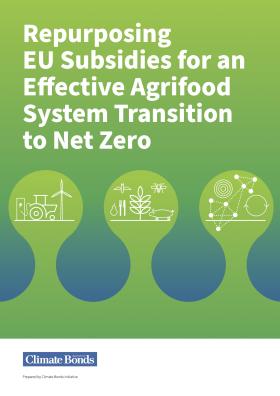When it comes to climate change, agriculture is one of the biggest elephants in the room. It is a massive emitter – responsible for 11% of the EU’s GHG emissions – but also one of the first sectors to feel the heat. From droughts to floods, farmers are already seeing the effects of a changing climate.
The good news? With the right policies and investments, agriculture can go from being part of the problem to a huge part of the solution. That is the message of the latest Climate Bonds policy paper, “Repurposing EU Subsidies for an Effective Agrifood System Transition to Net Zero.”
Why the Status Quo Just Won’t Cut It
 Progress in agricultural emissions has been slow. Between 2005 and 2021, the EU only managed a 3% reduction — barely a dent. Meanwhile, the EU has ambitious goals to cut emissions by 55% by 2030 and hit net zero by 2050
Progress in agricultural emissions has been slow. Between 2005 and 2021, the EU only managed a 3% reduction — barely a dent. Meanwhile, the EU has ambitious goals to cut emissions by 55% by 2030 and hit net zero by 2050
The EU’s Common Agricultural Policy (CAP) – which makes up nearly 30% of the EU budget – needs a makeover. Right now, a huge chunk of that money does not support climate goals and titling these funds is a massive opportunity to support EU farmers in this transition. Despite earmarking 40% of its funds for climate-relevant activities, agricultural emissions remain largely stagnant. This misalignment calls for a comprehensive overhaul to repurpose subsidies and prioritise sustainability. Farmers need support to leap, as they face rising costs, unpredictable markets, and the pressure to produce affordable food.
What It Takes to Go Green
Getting agriculture on a net-zero path is going to be expensive, but repurposing CAP subsidies towards sustainable practices is one of the most effective ways to make that happen. The EU needs to invest EUR155bn of public funds every year to cut emissions by half by 2050.
The absence of agriculture in the EU Taxonomy for sustainable activities highlights a critical policy gap. But what does "sustainable" mean in the agriculture sector? Here is the catch: the EU doesn’t currently have a clear definition for what counts as sustainable agriculture, and this makes it tough to align policies and investments.
That is where sector-specific Criteria, such as those developed by Climate Bonds come in.
Here’s how the EU can help
1. Reward Green Practices, aligning CAP subsidies with science-based criteria. Shift subsidies to support eco-friendly farming methods like organic practices, crop rotation, and precision agriculture.
2. Encourage private investment through sustainable debt markets and certifications.
3. Introduce eco-schemes with clear and ambitious climate goals.
A Once-in-a-Generation Opportunity
The EU has a golden opportunity to rethink how it spends its agricultural subsidies. The new EU Commission will review CAP plans in 2025, giving policymakers the chance to turn the CAP into a powerhouse for climate action.
This Climate Bonds policy paper shows the way forward. It is about aligning subsidies with science, encouraging private investment, and helping farmers transition to a more sustainable future. With the right support, agriculture can thrive while helping the planet.
‘Til next time.
Climate Bonds
